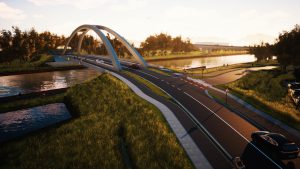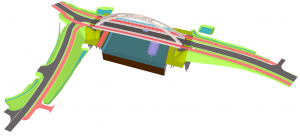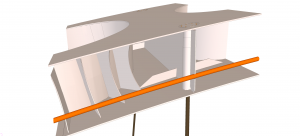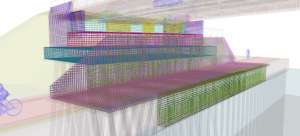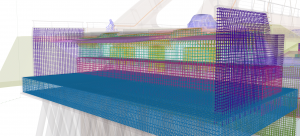Nieuwe Leiebrug Bissegem-Marke
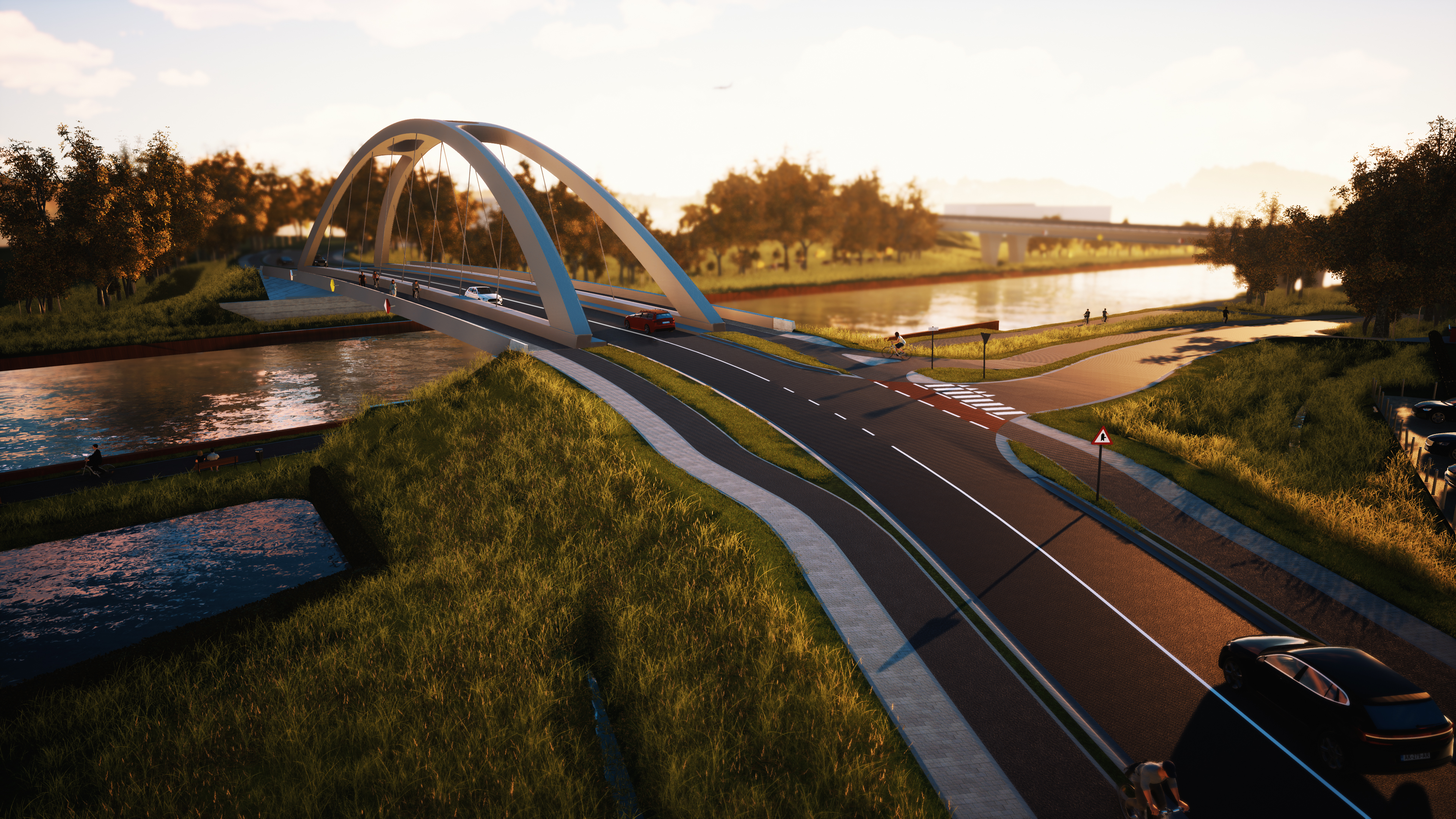
| Kategorie | Projekty infrastruktury |
|---|---|
| Rok | 2020 |
| Země | Benelux |
| Organizace | Tractebel-Engie |
| Autor | Tom Vernimmen |
| Spoluautoři | Tractebel Engie (URBAN, WATER) |
| Klient | De Vlaamse Waterweg |
| Místo stavby | Kortrijk (B) |
| Tags |
Uitdaging
De opdracht voor De Vlaamse Waterweg is tweeledig. Enerzijds moet de bestaande brug over de Leie tussen Bissegem en Marke vernieuwd worden, teneinde de doorvaarhoogte te vergroten om zo passage van binnenschepen met drie lagen containers te faciliteren. Anderzijds moet ook de vernauwing van de Leie onder de brug aangepakt worden. De vaarweg moet namelijk overal breed genoeg zijn om vlot scheepvaartverkeer te garanderen.
Gezien deze dubbele problematiek, is de exacte locatie en positie van de nieuwe brug voorwerp voor verder onderzoek. Na het grondig afwegen van alle voor- en nadelen van de verschillende opties, is er gekozen voor een gedeeltelijk nieuwe locatie. Die conclusie is het resultaat van een iteratieve, integrale afweging gevoed vanuit verkeerskundige, infrastructurele, nautische en bouwtechnische randvoorwaarden en uitgangspunten. Het integraal coördinatiemodel speelde daarin een sleutelrol.
De nieuwe brug wordt een stalen boogbrug. Het ontwerp oogt licht en hedendaags. Het fiets- en voetpad komt aan beide buitenzijden van de brug. De zwakke weggebruikers worden dus fysiek afgescheiden van het wegverkeer waardoor de kans op ongevallen aanzienlijk verkleint. De jaagpaden lopen door onder de brug en worden aangesloten op de wegenis, waardoor er een vlotte fietsverbinding gecreëerd wordt.
Tijdens de bouw van de nieuwe brug zal de bestaande brug niet meer toegankelijk zijn voor het verkeer. Voor de fietsers -en voetgangers zal een tijdelijke brug worden voorzien zodat zij tijdens de werken de Leie over kunnen. Fasering is dus belangrijk. Het in 3D en 4D visualiseren van de nieuwe brug en haar nieuwe positie helpt inzake draagvlakvorming.
Om de bovenvermelde uitdagingen te tackelen dienden verschillende disciplines binnen Tractebel intens samen te werken en informatie uit te wisselen. Een uitgelezen kans om een geïntegreerde BIM-aanpak uit te rollen en de aspecten bestaande toestand, nutsvoorzieningen, infrastructuur, architectuur, veiligheid, onderhoud, duurzaamheid en ecologie maximaal op elkaar af te stemmen.
Samenwerkingsproces
Tijdens het ontwerpproces was het erg belangrijk om een manier te vinden om de informatie efficiënt uit te wisselen, omdat iedereen binnen zijn domein werkt in het daartoe meest geschikte ontwerppakket.
Intra disciplinair heeft parametrisch ontwerp een belangrijke bijdrage geleverd tot een gestroomlijnd ontwerp proces. De tool die daarvoor gebruikt werd is de grafische programmeer omgeving Grasshopper, een plug-in van Rhinoceros. Deze laatste software tool werd gebruikt om de abstracte algoritmische weergave van de bruggeometrie te visualiseren.
De bruggeometrie is op deze manier erg flexibel en kan op intuïtieve wijze snel aangepast worden door de input parameters te laten variëren. De structureel ontwerper kan bijgevolg de geometrie optimaliseren naar de optredende randvoorwaarden.
Concreet: brug- en weggeometrie zijn erg aan elkaar gerelateerd; wijzigingen aan het wegontwerp hebben rechtstreekse invloed op de brugstructuur en omgekeerd. Zo werd het weg- en brugontwerp in verschillende stadia aangepast ten gevolge van volgende randvoorwaarden:
• maximale hellingen van het fietspad in de aanloophellingen
• garantie van de vrije doorvaarthoogte onder de brug na zetting van de landhoofden en vervorming van de staalstructuur
• brugontwerp symmetrisch t.o.v. de as van de Leie
• helling van de boogvlakken i.f.v. profiel van vrije ruimte benodigd door het wegverkeer op de brug
• optimaliseren van detaillering in de staalstructuur
Op basis van Grasshopper-scripts kunnen geometrische gegevens gemakkelijk worden geëxporteerd naar een analysemodel (Scia Engineer) om interne krachten, spanningen en vervormingen te berekenen. Zelfs belastingen, belastingsgevallen, scharnieren en steunpunten kunnen aan deze scripts worden toegevoegd en geëxporteerd naar de berekeningssoftware. De flexibiliteit in het creëren van verschillende geometrieën die in korte tijd kunnen worden berekend, in een vroege fase van het ontwerpproces hebben geleid tot meer inzicht en uiteindelijk tot een betere kwaliteit van het ontwerp.
Met behulp van dezelfde Grasshopper scripts wordt de brugstructuur automatisch gegenereerd in een structuurmodel. Uiteraard moet er meer detail aan dit model worden toegevoegd en dat kan door de basisscripts uit te breiden om zo tot een echt 3D model te komen dat leidt tot een definitief ontwerp.
Want dat is wat we uiteindelijk willen bereiken, een set van deliverables: 2D plan extracten, meetstaten, 3D wapeningsmodellen, buigschema’s,…
Interdisciplinair samenwerken en informatie op digitale wijze uitwisselen heeft geleid tot een integraal en gecoördineerd ontwerpmodel, dat ingezet werd als communicatietool (ontwerpteam), visualisatietool (stakeholders) en verificatietool (clash detectie).
Op vlak van wegontwerp staat de ontwikkeling van IFC standaarden nog niet op een volledig operationeel niveau. Enkel voor de overdracht van alignementen zijn IFC-extensies ontwikkeld. Verdere ontwikkelingen in een Europees kader zijn lopende en zullen in toekomst kunnen geïntegreerd worden in de BIM methodiek van ontwerpteams.
Voor dit project werd daarom gekozen om het coördinatiemodel te beheren in Navisworks, wat een directe link heeft met het native bestandsformaat (Civil 3D) van het wegontwerp. De civiele structuren (brug, landhoofden, kaaimuren) werden gemodelleerd in Tekla en uitgewisseld met het coördinatiemodel d.m.v. IFC.
Conclusie
Door een geïntegreerd model te bouwen en BIM processen op elkaar af te stemmen heeft Tractebel een bouwbaar detail ontwerp afgeleverd voor zowel de bovenbouw (stalen brug), onderbouw (landhoofden, keerwanden en kaaimuren) als infrastructuur (wegontwerp en riolering).
Challenge
The assignment for De Vlaamse Waterweg is twofold. On the one hand, the existing bridge over the river Leie between Bissegem and Marke has to be renewed in order to increase the clearance height to facilitate the passage of inland vessels with three layers of containers. On the other hand, the narrowing of the river Leie under the bridge also needs to be tackled. Indeed, the waterway must be wide enough everywhere to guarantee smooth shipping traffic.
Given this double challenge, the exact location and position of the new bridge is a subject for further research. After thorough consideration of all the advantages and disadvantages of the various options, a partially new location has been chosen. This conclusion is the result of an iterative, integral consideration fed by traffic engineering, infrastructural, nautical and technical preconditions and starting points. The integral coordination model played a key role in this.
The new bridge will be a steel arch bridge. The design looks light and contemporary. The bicycle and footpath will be on both sides of the bridge. Slow traffic will therefore be physically separated from road traffic, which considerably reduces the risk of accidents. The towpaths continue under the bridge and are connected to the road design, creating a smooth cycling connection.
During the construction of the new bridge, the existing bridge will no longer be accessible to traffic. A temporary bridge will be provided for cyclists and pedestrians so crossing the river Leie during the works remains possible. Phasing is therefore important. Visualizing the new bridge and its new position in 3D and 4D will help to create support.
In order to tackle the above-mentioned challenges, various disciplines within Tractebel had to work together intensively and exchange information. An excellent opportunity to roll out an integrated BIM approach and to harmonize the aspects of existing condition, utilities, infrastructure, architecture, safety, maintenance, sustainability and ecology as much as possible.
Collaboration process
During the design process it was very important to find a way to exchange information efficiently, because all disciplines use best-fit-for-purpose design tools.
Intra disciplinary, parametric design made an important contribution to a streamlined design process. The tool used was the graphical programming environment Grasshopper, a plug-in from Rhinoceros. This latter software tool was used to visualize the abstract algorithmic representation of the bridge geometry.
In this way, the bridge geometry is very flexible and can be quickly and intuitively adjusted by varying the input parameters. As a result, the structural designer can optimize the geometry to the occurring boundary conditions.
In concrete terms: bridge and road geometry are very interrelated; changes to the road design have a direct influence on the bridge structure and vice versa. For example, the road and bridge design was adapted in different stages as a result of the following preconditions:
– maximum gradients of the cycle path in the approach slopes
– guarantee of the free clearance height under the bridge after settling of the abutments and deformation of the steel structure
– bridge design symmetrical to the axis of the river Leie
– Inclination of arch in relation to the profile of free space required by road traffic on the bridge.
– optimization of detailing in the steel structure
Based on Grasshopper scripts, geometric data can easily be exported to an analysis model (Scia Engineer) to calculate internal forces, stresses and deformations. Even loads, load cases, hinges and supports can be added to these scripts and exported to the calculation software. The flexibility in creating different geometries that can be calculated in a short period of time, in an early phase of the design process has led to more insight and ultimately to a better design quality.
Using the same Grasshopper scripts, the bridge structure is automatically generated in a structural model. Of course more detail needs to be added to this model and this can be done by extending the basic scripts to create a real 3D model that leads to a final design.
Because that is what we ultimately want to achieve, a set of deliverables: 2D plan extracts, bills of quantity, 3D reinforcement models, bending schedules,…
Interdisciplinary collaboration and information exchange in a digital way led to an integrated and coordinated design model, which was used as a communication tool (design team), visualization tool (stakeholders) and verification tool (clash detection).
In terms of road design, the development of IFC standards is not yet at a fully operational level. IFC extensions have only been developed for the transfer of alignments. Further developments in a European framework are ongoing and will be integrated in the BIM methodology of design teams in the future.
For this project it was therefore decided to manage the coordination model in Navisworks, which has a direct link with the native file format (Civil 3D) of the road design. The civil structures (bridge, abutments, quay walls) were modelled in Tekla and exchanged with the coordination model using IFC.
Conclusion
By building an integrated model and aligning BIM processes, Tractebel delivered a feasible detailed design for both the superstructure (steel bridge), substructure (abutments, retaining walls and quay walls) and infrastructure (road design and sewerage).
